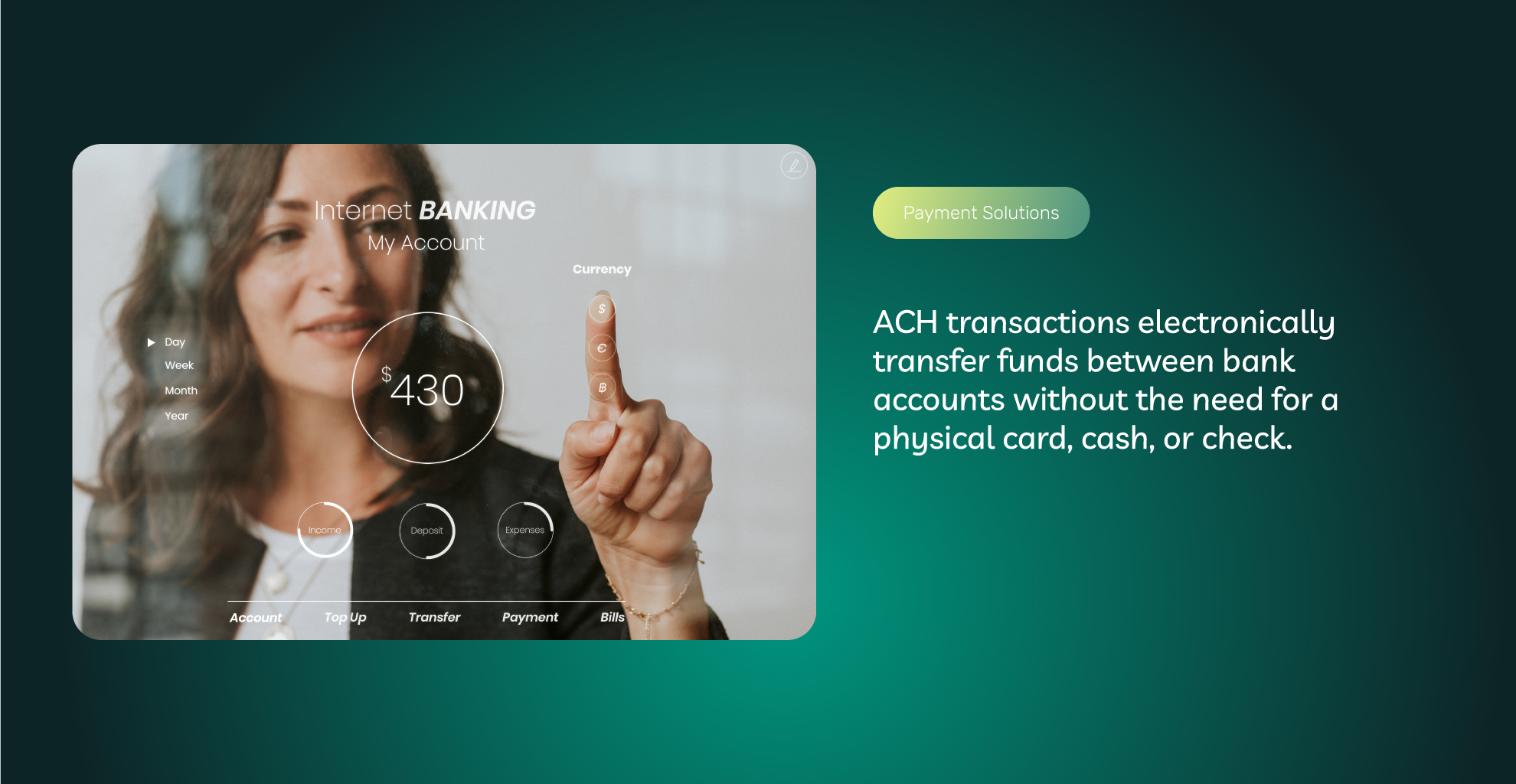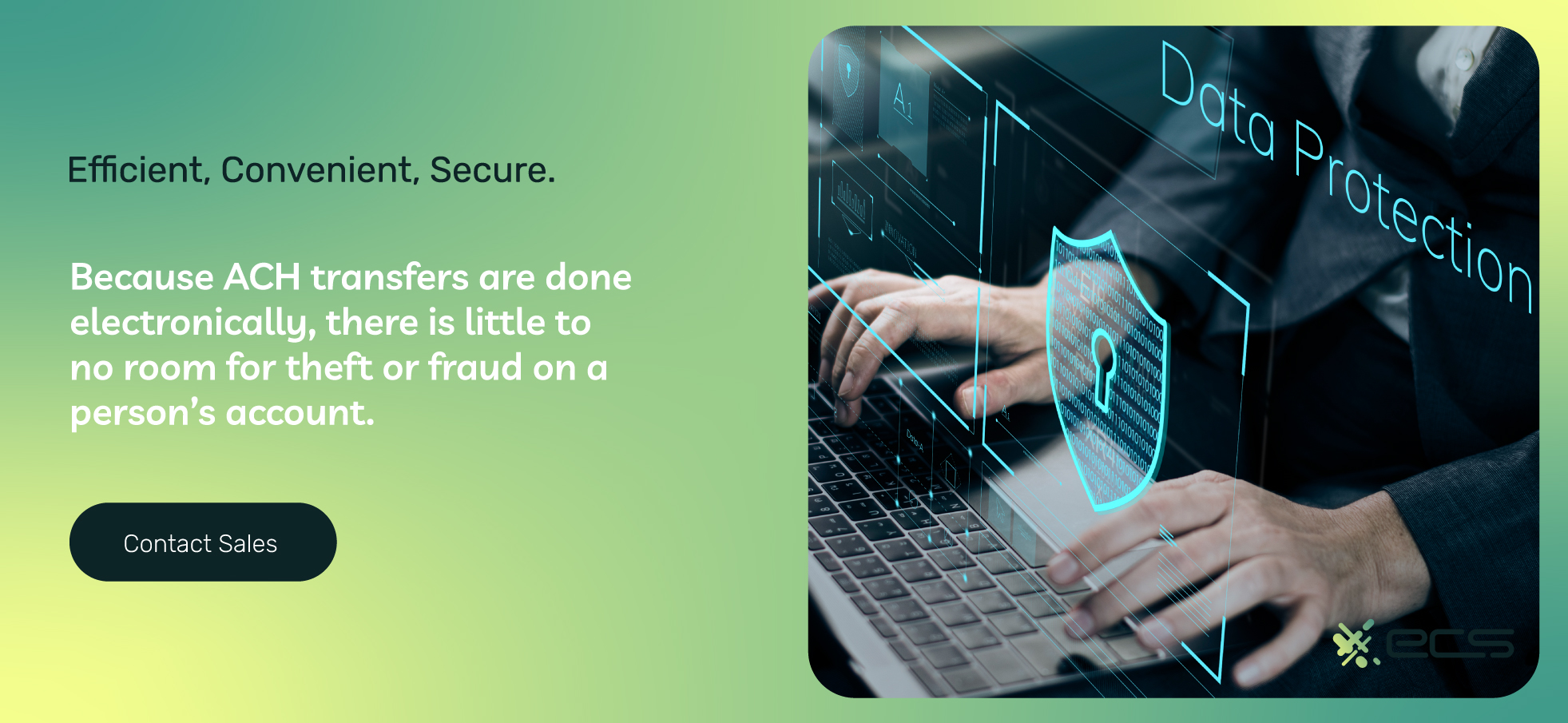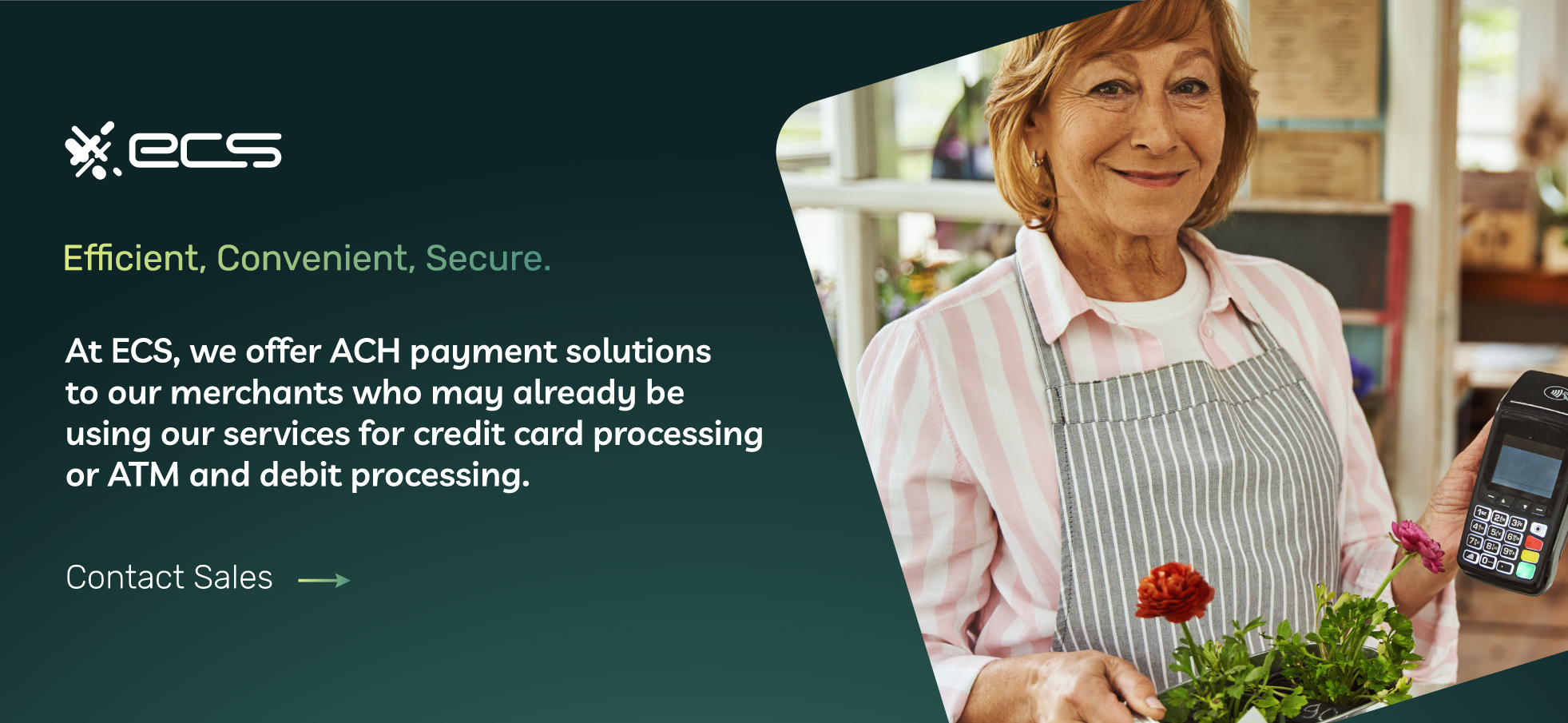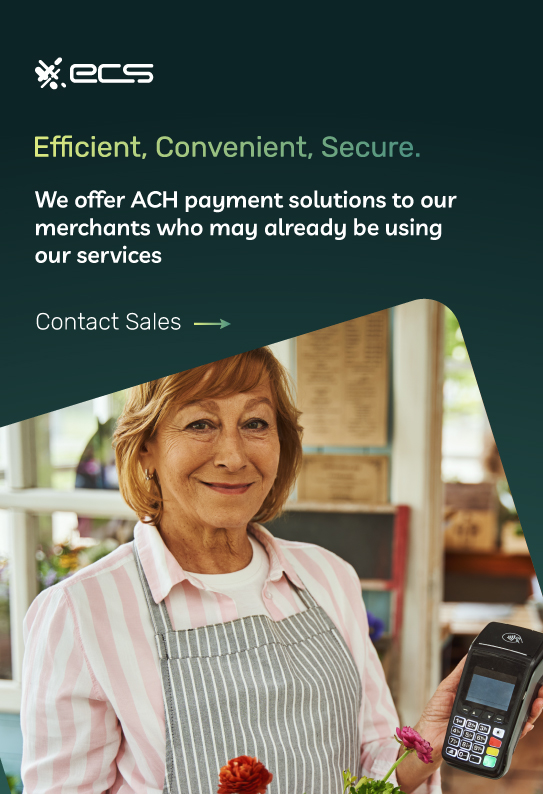ACH transactions continue to revolutionize how businesses send and receive funds. From streamlining payroll processes to simplifying recurring billing online, ACH has opened the door to a smarter payment future.
This article dives into the key aspects of ACH transactions. We explore how it works, its benefits, and how it is reshaping the way merchants are doing business. Discover why ACH is a payment solution that your business can enjoy for a more efficient financial impact, with less cost.
What is ACH?
ACH (Automated Clearing House) transactions are a payment solution, unlike credit card processing, to electronically transfer funds without the need for a card, cash, check, or any other form of payment. ACH is a transfer of funds from one bank account to another electronically, otherwise known as an E-check.
With the convenience of ACH payment processing solutions, you can accomplish the transfer of funds for tasks such as a direct deposit for payroll, recurring payment plans, business-to-business transactions, bill pay, and more.
When to Use ACH
ACH can be used in one of two ways. You can initiate an electronic funds transfer from your bank account to another bank account or from another bank account to yours. In other words, you can debit or credit another bank account, in which your bank account would then be used to balance this transfer.

Crediting With ACH Payments
Crediting another bank account through ACH payment would be done for the following scenarios:
Direct deposit or payroll
Direct deposit is the most popular form of ACH transfer. This is used to initiate funding, such as payroll from employer to employee. A direct deposit would be electronically moving funds from your bank account to your employee’s checking or savings account. We want our merchants to be able to utilize all of our services for any of their needs and not have to switch between providers for different services. We also offer ACH solutions as a stand-alone service as well if this is the best option to run all of your funds transfers for your business.
Issuing a refund
You can issue a refund if a customer, for any reason, is due back their funds, and ACH was used to process their initial payment. You can return their funds by issuing a second ACH to then credit their account back.
Blind credit
If you own money to send or loan type of business, you can process these types of credits and transfer money with ACH processing.
Bill pay
Paying your bills to other vendors (electric, rent, internet, etc.) can oftentimes be done via ACH rather than cutting a paper check or paying with a credit card.
Debiting With ACH Payments
Debiting another bank account through ACH payment would be done for the following scenarios:
Initiating a customer transaction
If you are a merchant who takes payment online, otherwise known as e-commerce, or has a money-send or loan-type business, or has the flexibility to offer payment options to your customer where a card or physical terminal would not be necessary.
ACH may be a great option for you.
Bill pay and subscriptions
You can easily generate fully automated recurring payment plans on our virtual terminal. By choosing this option for recurring plans for repeat customers, you will negate manual errors in entering transaction information, clear up free time to focus on other areas of your job and increase productivity for your employees who may handle payments, payroll, and collections. You can also generate and print client receipts and invoices with ECS’s virtual terminal features.
ACH Features And Benefits
With ECS’s ACH processing services and features, you can easily streamline your business and eliminate the hassle that comes with many daily or monthly tasks associated with running a successful operation. ACH has added benefits such as convenience, cost-effectiveness, security, and reporting ease with tracking and managing payments. ECS offers additional tools to help you succeed when using these services.
Convenience
Writing checks is not something you see quite as often these days. That is because, with ACH processing solutions, paper checks are dissolving and are transitioning into e-checks. ACH provides the convenience of electronically moving funds with the click of a button rather than ordering a checkbook, writing a check, stuffing an envelope, and delivering it to the mailbox.
Choosing to save time and energy on how payments are made is the direction you should consider heading toward to keep up in today’s society as an up-to-date and modern business.
Using the ACH platform is a wonderful processing solution if you are looking for ease and convenience when it comes to paying your bills and your employees or setting up recurring bill pay for customers who have monthly payments.
The flexibility and stress-reducing capabilities it offers are no match to manually running debit cards, credit cards, or physical checks every month for the same customer and the same amount. We like to say, “Set it and forget it”. Take the extra time this gives you to better your business for a more successful tomorrow.
Cost-effectiveness
Choosing to accept ACH payments is a more economical alternative to credit card processing or wire transfers. Because credit card payments go through various credit card networks and issuing banks, there are different fees associated with each transaction, such as interchange rates, discount rates, network fees, processor fees, physical terminal fees, qualifying vs. non-qualifying fees, and how the card runs (keyed, swiped or dipped) can also affect your fees!
These different fees will add up to a higher processing cost than that of using ACH for your electronic movement of funds. ACH uses only one processing network, which is solely the Automated Clearing House network. Because of this, fees are relatively cost-effective and affordable for merchants.

Advanced Reporting Tools
Another option to streamline your business and receive the benefits of ACH processing with our virtual terminal is with our advanced reporting tools. With our tools, you will have the ability to view and download reports for transaction history, batch history, and settlement history.
You can search any type of transaction by the desired and specific field you need to locate, such as amount, date, account number, account name, successful or unsuccessful transactions, etc.
Our reporting tool also shows a live view of where your transaction is at in the ACH process. Is the transaction capture successful? Was the batch submitted successfully? Is the settlement successful, or did the funds come back returned and unsuccessful?
All these questions can be answered just by logging in, viewing your daily transactions, and following along with the transaction history.
Security
Because ACH transfers are done electronically, there is little to no room for theft or fraud on a person’s account. Transactions done through the ACH network cannot be intercepted in its process by criminal activity.
Additionally, because this type of transaction is fully electronic, there is no paper trail of a check and no physical card that can be stolen or lost.
How to Ensure Secure ACH Transactions
Even though ACH transactions are inherently secure, there are always loopholes for fraud. Therefore, it is important that you understand all the best practices to minimize your risk and secure your business.
Unlike the credit card networks, the Automated Clearing House Network does not require PCI DSS compliance. However, this does not mean merchants can slack on their role in safeguarding their clients’ sensitive information.
Because ACH transactions are known for their ease and efficiency, it is even more crucial for businesses to implement robust security measures to prevent unauthorized access into virtual terminals, which would result in easy money transfers to unauthorized recipients.
Here are some proactive steps that business owners can take to mitigate risks.
Encryption and Tokenization
At ECS Payments, all our payment processing solutions come with encryption and tokenization capabilities for secure payment processing for any environment and any industry.
Use Multi-Factor Authorization
Single-factor authorization means there is one security feature to access a network or device, such as a single password. Two-factor authorization (2FA) or multi-factor authorization (MFA) adds an additional layer of authentication on top of the existing password or login credentials.
MFA sends an additional code to a separate device after the user inputs their login credentials. Entering the one-time code then grants access to the system.
Implement Password Policies
Implementing a password policy will deter employees from using general or easy-to-guess passwords. Password policies should outline the rules for password generation and secure password storage, such as through a password manager. A password manager can also help employees to keep track of hard-to-remember (but secure) passwords.
Use Secure Internet Connections
Whether you or your employees run ACH transactions at your physical store front or remotely, a secure internet connection is crucial. Using public Wi-Fi can severely threaten the security of your transactions. Therefore, you must never access sensitive information or run transactions over public Wi-Fi.
However, if your location does use a Wi-Fi network for your internet, ensure you and your employees turn off auto-connect and double-check that you are connecting to the right network for your business. Additionally, be sure to use a VPN for secure Wi-Fi encryption. VPNs help disguise your IP address and other sensitive device and login information.
How Does ACH Work?
With ACH transactions, there are multiple phases before the exchange is complete. There are three steps during an ACH transaction that you should become familiar with: processing, submitting, and settlement.


Processing
At ECS, you can easily process your ACH transactions through our all-inclusive virtual terminal.
All you would need to do is log in and enter your customer’s (end-user) information, such as their name or the business name, their bank account, and routing numbers (ABA and DDA).
Then, you will enter the amount you want electronically transferred and choose if this will be a debit or a credit (depending on what features you’ve signed up for).
Next, you’ll choose the method or SEC code from the drop-down (typically, this will be “PPD”), and click submit!
From here, the payment gateway will validate that you have entered all the necessary information. If you are missing something or the wrong SEC code was selected, you may receive an error. You will simply need to double-check your work and re-submit.
Submitting
Once you have completed all your transactions for the day, you can move on to the submission portion of the transaction.
In the same virtual terminal where you processed the payment initiation, you can also submit your daily batch to your payment processor, who then submits it to the ACH network. For merchants who are high volume, SFTP file uploading is also an available option we present.
Take note that there are cut-off times when it comes to submitting any type of batch in the payment processing world, regardless if it is for credit card transactions or ACH transactions.
If you do not submit your batch by the standardized cut-off time, you will not receive funding for your batch until the following day from when you would typically receive your batch.
Settlement
Once you have submitted your batch successfully, the file must be transferred to your ACH payment processor, who then, through the ACH network, sends the file to your customers’ banks, who then processes the files, validates the information, authorizes the transaction depending on available funds, any holds on the account, etc.
If the transaction information is valid, and there are appropriate funds in the customer’s account, the bank will then transfer the funds to the ACH processor, who will then submit the funds to your merchant bank account.
Because this process has to go through multiple parties and the bank account has to be verified, the settlement may take 3-5 business days. If you are a high-risk merchant, although you may be approved to process with us at ECS, you may be set up with a 2-day funding delay.
This would be to prevent any cases of crediting a merchant for a transaction when there may not be available funds in their customer’s bank account. This delay reduces the risk that may be involved with certain transactions between particular parties.
Rejected Or Returned ACH Transactions
If a customer’s bank flags a transaction file as unsuccessful, there will be a return or a reject code attached to the file as it is sent back.
Although the initial processing stage may show as successful, meaning you submitted the information successfully to the gateway, and then the batch was successfully submitted to the ACH processor, the bank may then process the file and determine that there are insufficient funds in the account, or the customer has put a “do not debit” block on the account.
Or maybe even the account number was entered wrong. Below is a list of the return or reject codes you may receive if the bank determines the ACH file is unsuccessful:
Depending on the reason for the return or rejection, otherwise known as the “R code,” you will need to speak to your customer and or double-check the bank account, routing, and SEC information that was entered for the transaction. If you mistyped the information, you may re-enter and re-submit. However, if the customer provided the wrong account information, has insufficient funds, or has put a block on the transaction, you will need to reach out to them to resolve the issue.
What Happens if I Make a Mistake When Processing an ACH Transaction?
One thing to keep in mind is when you submit a transaction via ACH, there is no ability to refund, void, reverse, or cancel this transaction. If you realize you made a mistake, or if the customer wishes to pay using alternative means, you can only correct this submission by submitting a new transaction in reverse.
For example, if you debit a customer for $100 and then realize they already made their monthly payment, the only way to balance this error would be to issue an additional transaction as a credit to their account for $100.
During these types of situations, although you will have made the correction to balance the error, each transaction, the original debit, and then the credit will take some time to process. Unlike credit card or debit card transactions, ACH processes take a few days to process, submit, and settle.

How does the ACH Network Work?
When it comes to understanding when and how funds will be moved and settled, you must understand how and when the ACH network functions. The ACH Network, just like most banks and financial institutions, does not settle funding on the weekends and or holidays.
This is due to the Federal Reserve being closed. Because of the weekend and holiday closures, the ACH network will do its best to favor the end user.
What is an End-user?
The end-user is the person who is the opposite of the initiator of the transaction. As a merchant, you would typically be initiating the transaction for either crediting an employee for payroll or initiating a debit to a customer’s bank for their bill payment, etc. This would then make your customer or your employee the end user.
According to NACHA, to favor the end-user during this industry’s off days, if payday, for example, was on the 1st, and this landed on a Saturday, the direct deposit payment via ACH would occur on the previous Friday. If a bill payment is due on the 1st, which would also land on this Saturday, for example, the fund’s transfer via ACH would be initiated on the next business day, which would be the following Monday.
What is NACHA?
NACHA stands for National Automated Clearing House Association. They develop, administer, and oversee the private sector for guidelines, roles, and responsibilities regarding electronic payments and ACH network participants in the United States.
Their goal is to maintain a secure network while safely growing and enhancing the use of ACH transactions, utilizing innovation and collaboration.
At ECS, we are proudly Nacha Certified. This means we maintain upstanding policies fair and honest ACH practices, and our compliance and risk programs are first-class.
Process ACH Transactions with ECS
As our mission declares, ECS aims to be a “One Stop Shop” for all payment and product needs. There are many payment options out there to choose from in the world of merchant services. One of our popular product solutions chosen by our merchants today is ACH payment processing.
Through the Automated Clearing House network (ACH), ECS provides secure, dependable solutions for electronic fund transfers from one bank account to another as an accessible alternative to paper checks and a more cost-effective alternative to credit card processing.
We want our merchants to be able to utilize all of our services for any of their needs and not have to switch between providers for different services. We also offer ACH solutions as a stand-alone service as well if this is the best option to run all of your funds transfers for your business.

What are the Downsides of ACH Processing?
Although ACH triumphs in being more economical and efficient than alternative payment solutions, one of the downsides of ACH processing is the settlement time. Meaning, that if you need to be funded immediately, credit card or debit card processing may be a better alternative to meet your needs.
Alternative to ACH Processing
Many businesses today have the option to process their transactions through different avenues. One alternative to ACH processing is the most common platform of credit card processing.
Although credit card processing is the most widely practiced form of accepting payments with today’s merchants, credit card processing poses its own differences from ACH. Fees, time, and convenience are some of the main differences when it comes to comparing ACH with credit card processing.
Wrap up
Accepting ACH payments is a wonderful tool that is widely used in today’s market, whether you are using it to pay or get paid. At ECS, we offer ACH payment solutions to our merchants who may already be using our services for credit card processing or ATM and debit processing.
The payment processing solution you choose will ultimately depend on the type of business you have and what the best way to facilitate the movement of funds will be for your personnel and consumers. If you are ready to explore which payment processing solution would be best suited for your business endeavors, ECS is ready to connect with you!
To contact sales, click HERE. And to learn more about ECS ACH Payment Solutions, visit ACH.
Updated January 2024
